CNA345 Assessment Task 1: CVAD Complications and Evidence-Based Care
VerifiedAdded on 2020/05/28
|11
|2848
|306
Report
AI Summary
This report analyzes the case of Jim Karas, a patient who developed complications related to a central venous access device (CVAD). It explores the factors contributing to the development of CVAD-related issues, including Central Line Associated Bloodstream Infections (CLABSI) and vascular occlusion. The report emphasizes the importance of evidence-based nursing practices in preventing and managing these complications. It discusses various intrinsic and extrinsic risk factors, along with guidelines from the Centre for Disease Control and Prevention. The report highlights the significance of aseptic techniques, hand hygiene, and proper catheter care. It also suggests an action plan, including the use of antimicrobial catheters and thrombolytic agents, along with the importance of patient and family involvement in the decision-making process. The report concludes by emphasizing the effectiveness of evidence-based strategies in improving patient outcomes and preventing healthcare-acquired infections.
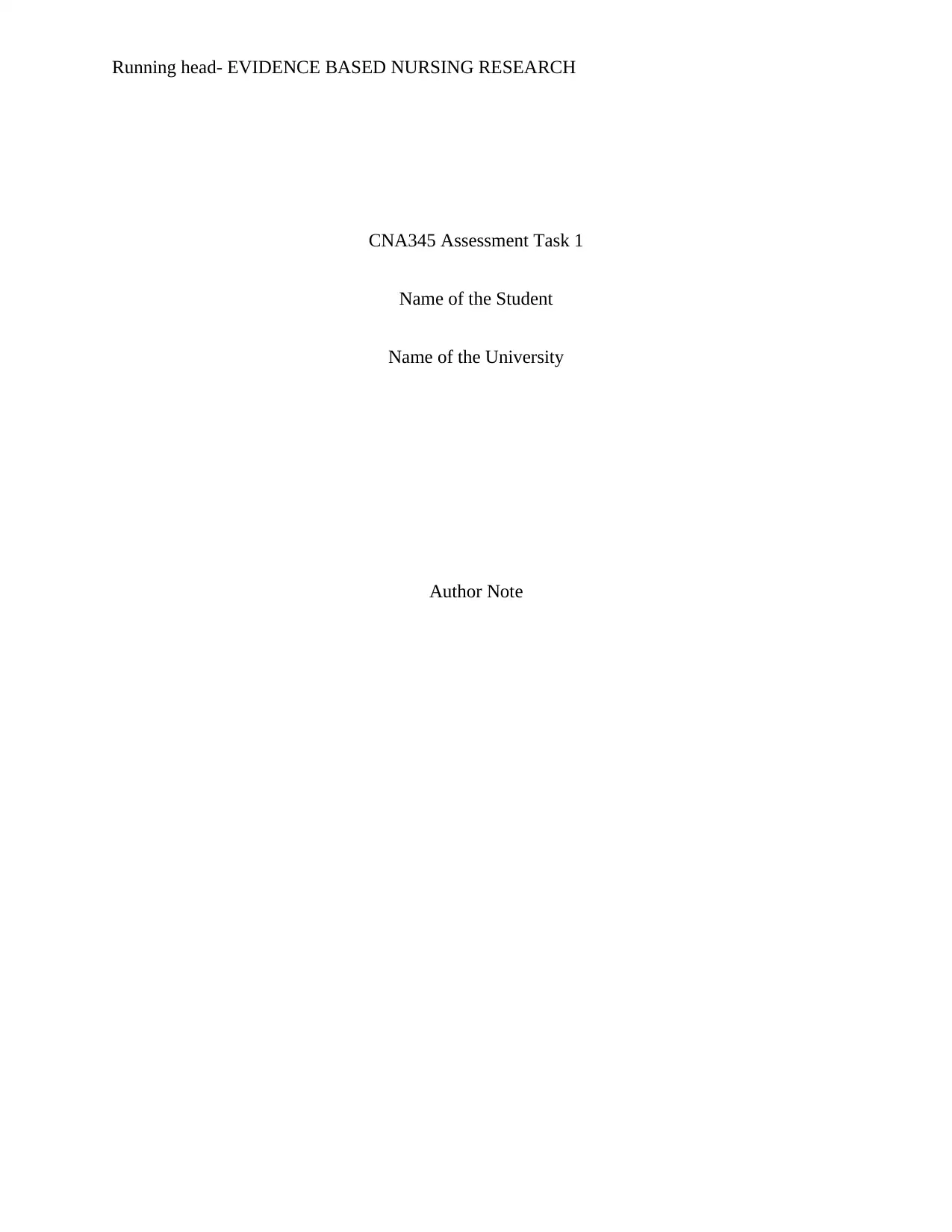
Running head- EVIDENCE BASED NURSING RESEARCH
CNA345 Assessment Task 1
Name of the Student
Name of the University
Author Note
CNA345 Assessment Task 1
Name of the Student
Name of the University
Author Note
Paraphrase This Document
Need a fresh take? Get an instant paraphrase of this document with our AI Paraphraser
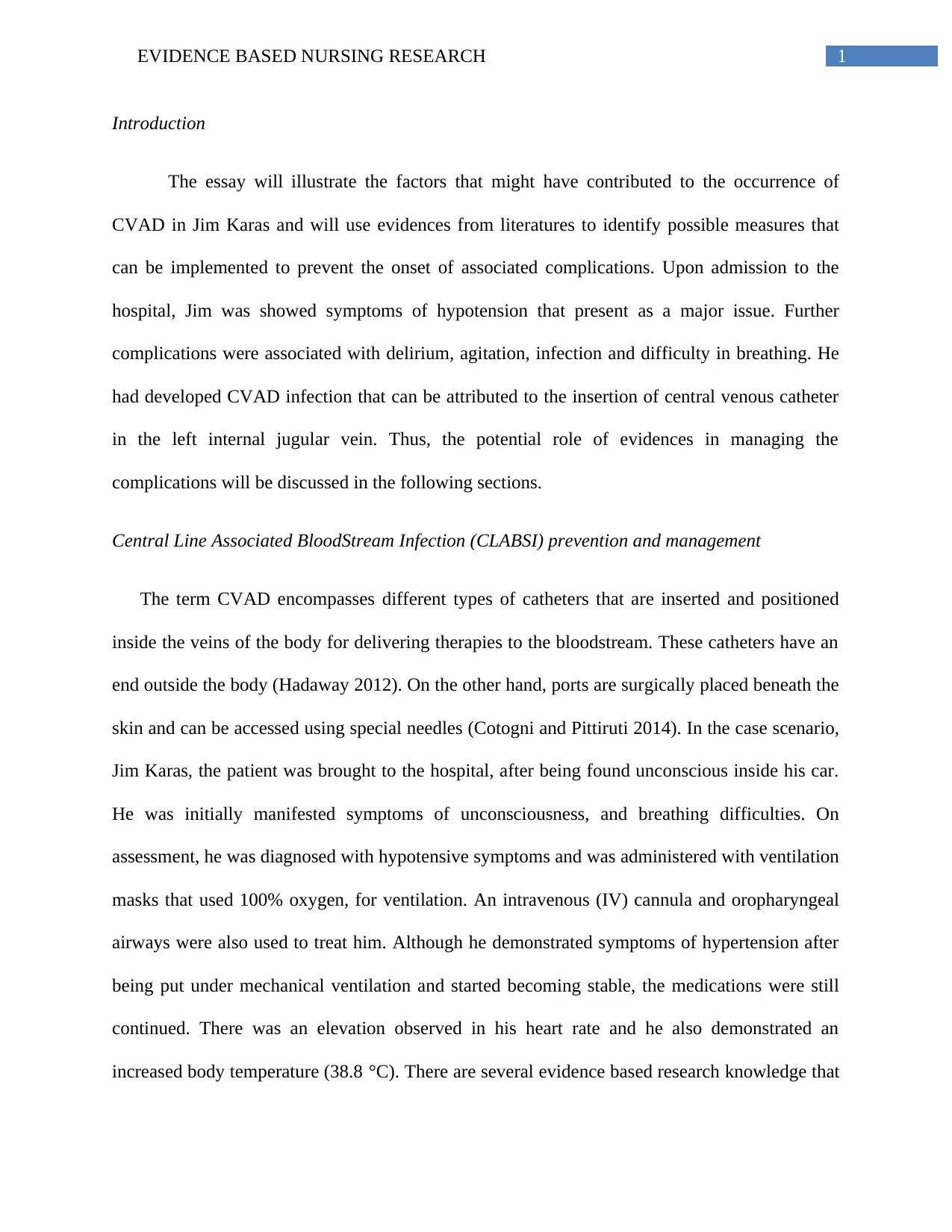
1EVIDENCE BASED NURSING RESEARCH
Introduction
The essay will illustrate the factors that might have contributed to the occurrence of
CVAD in Jim Karas and will use evidences from literatures to identify possible measures that
can be implemented to prevent the onset of associated complications. Upon admission to the
hospital, Jim was showed symptoms of hypotension that present as a major issue. Further
complications were associated with delirium, agitation, infection and difficulty in breathing. He
had developed CVAD infection that can be attributed to the insertion of central venous catheter
in the left internal jugular vein. Thus, the potential role of evidences in managing the
complications will be discussed in the following sections.
Central Line Associated BloodStream Infection (CLABSI) prevention and management
The term CVAD encompasses different types of catheters that are inserted and positioned
inside the veins of the body for delivering therapies to the bloodstream. These catheters have an
end outside the body (Hadaway 2012). On the other hand, ports are surgically placed beneath the
skin and can be accessed using special needles (Cotogni and Pittiruti 2014). In the case scenario,
Jim Karas, the patient was brought to the hospital, after being found unconscious inside his car.
He was initially manifested symptoms of unconsciousness, and breathing difficulties. On
assessment, he was diagnosed with hypotensive symptoms and was administered with ventilation
masks that used 100% oxygen, for ventilation. An intravenous (IV) cannula and oropharyngeal
airways were also used to treat him. Although he demonstrated symptoms of hypertension after
being put under mechanical ventilation and started becoming stable, the medications were still
continued. There was an elevation observed in his heart rate and he also demonstrated an
increased body temperature (38.8 °C). There are several evidence based research knowledge that
Introduction
The essay will illustrate the factors that might have contributed to the occurrence of
CVAD in Jim Karas and will use evidences from literatures to identify possible measures that
can be implemented to prevent the onset of associated complications. Upon admission to the
hospital, Jim was showed symptoms of hypotension that present as a major issue. Further
complications were associated with delirium, agitation, infection and difficulty in breathing. He
had developed CVAD infection that can be attributed to the insertion of central venous catheter
in the left internal jugular vein. Thus, the potential role of evidences in managing the
complications will be discussed in the following sections.
Central Line Associated BloodStream Infection (CLABSI) prevention and management
The term CVAD encompasses different types of catheters that are inserted and positioned
inside the veins of the body for delivering therapies to the bloodstream. These catheters have an
end outside the body (Hadaway 2012). On the other hand, ports are surgically placed beneath the
skin and can be accessed using special needles (Cotogni and Pittiruti 2014). In the case scenario,
Jim Karas, the patient was brought to the hospital, after being found unconscious inside his car.
He was initially manifested symptoms of unconsciousness, and breathing difficulties. On
assessment, he was diagnosed with hypotensive symptoms and was administered with ventilation
masks that used 100% oxygen, for ventilation. An intravenous (IV) cannula and oropharyngeal
airways were also used to treat him. Although he demonstrated symptoms of hypertension after
being put under mechanical ventilation and started becoming stable, the medications were still
continued. There was an elevation observed in his heart rate and he also demonstrated an
increased body temperature (38.8 °C). There are several evidence based research knowledge that
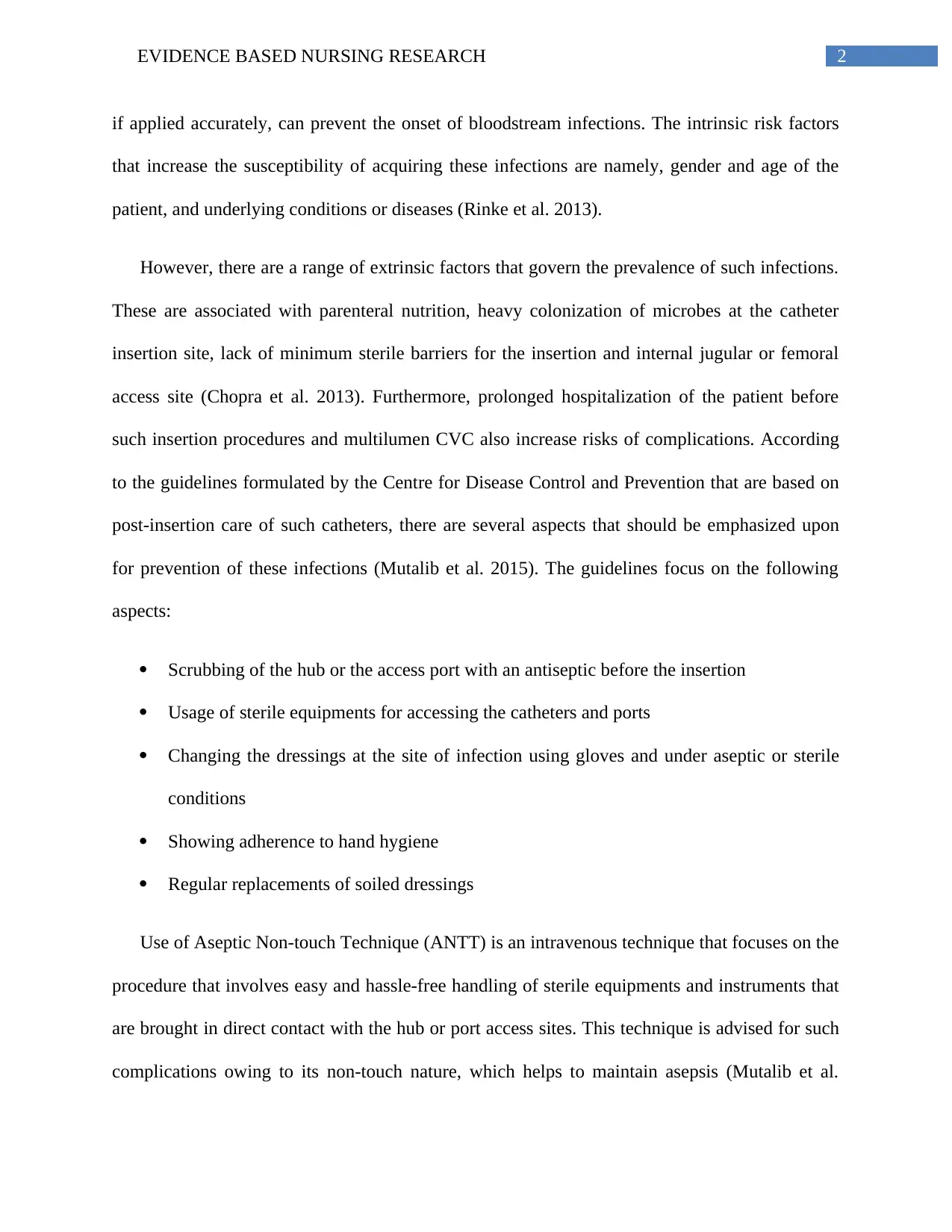
2EVIDENCE BASED NURSING RESEARCH
if applied accurately, can prevent the onset of bloodstream infections. The intrinsic risk factors
that increase the susceptibility of acquiring these infections are namely, gender and age of the
patient, and underlying conditions or diseases (Rinke et al. 2013).
However, there are a range of extrinsic factors that govern the prevalence of such infections.
These are associated with parenteral nutrition, heavy colonization of microbes at the catheter
insertion site, lack of minimum sterile barriers for the insertion and internal jugular or femoral
access site (Chopra et al. 2013). Furthermore, prolonged hospitalization of the patient before
such insertion procedures and multilumen CVC also increase risks of complications. According
to the guidelines formulated by the Centre for Disease Control and Prevention that are based on
post-insertion care of such catheters, there are several aspects that should be emphasized upon
for prevention of these infections (Mutalib et al. 2015). The guidelines focus on the following
aspects:
Scrubbing of the hub or the access port with an antiseptic before the insertion
Usage of sterile equipments for accessing the catheters and ports
Changing the dressings at the site of infection using gloves and under aseptic or sterile
conditions
Showing adherence to hand hygiene
Regular replacements of soiled dressings
Use of Aseptic Non-touch Technique (ANTT) is an intravenous technique that focuses on the
procedure that involves easy and hassle-free handling of sterile equipments and instruments that
are brought in direct contact with the hub or port access sites. This technique is advised for such
complications owing to its non-touch nature, which helps to maintain asepsis (Mutalib et al.
if applied accurately, can prevent the onset of bloodstream infections. The intrinsic risk factors
that increase the susceptibility of acquiring these infections are namely, gender and age of the
patient, and underlying conditions or diseases (Rinke et al. 2013).
However, there are a range of extrinsic factors that govern the prevalence of such infections.
These are associated with parenteral nutrition, heavy colonization of microbes at the catheter
insertion site, lack of minimum sterile barriers for the insertion and internal jugular or femoral
access site (Chopra et al. 2013). Furthermore, prolonged hospitalization of the patient before
such insertion procedures and multilumen CVC also increase risks of complications. According
to the guidelines formulated by the Centre for Disease Control and Prevention that are based on
post-insertion care of such catheters, there are several aspects that should be emphasized upon
for prevention of these infections (Mutalib et al. 2015). The guidelines focus on the following
aspects:
Scrubbing of the hub or the access port with an antiseptic before the insertion
Usage of sterile equipments for accessing the catheters and ports
Changing the dressings at the site of infection using gloves and under aseptic or sterile
conditions
Showing adherence to hand hygiene
Regular replacements of soiled dressings
Use of Aseptic Non-touch Technique (ANTT) is an intravenous technique that focuses on the
procedure that involves easy and hassle-free handling of sterile equipments and instruments that
are brought in direct contact with the hub or port access sites. This technique is advised for such
complications owing to its non-touch nature, which helps to maintain asepsis (Mutalib et al.
⊘ This is a preview!⊘
Do you want full access?
Subscribe today to unlock all pages.

Trusted by 1+ million students worldwide
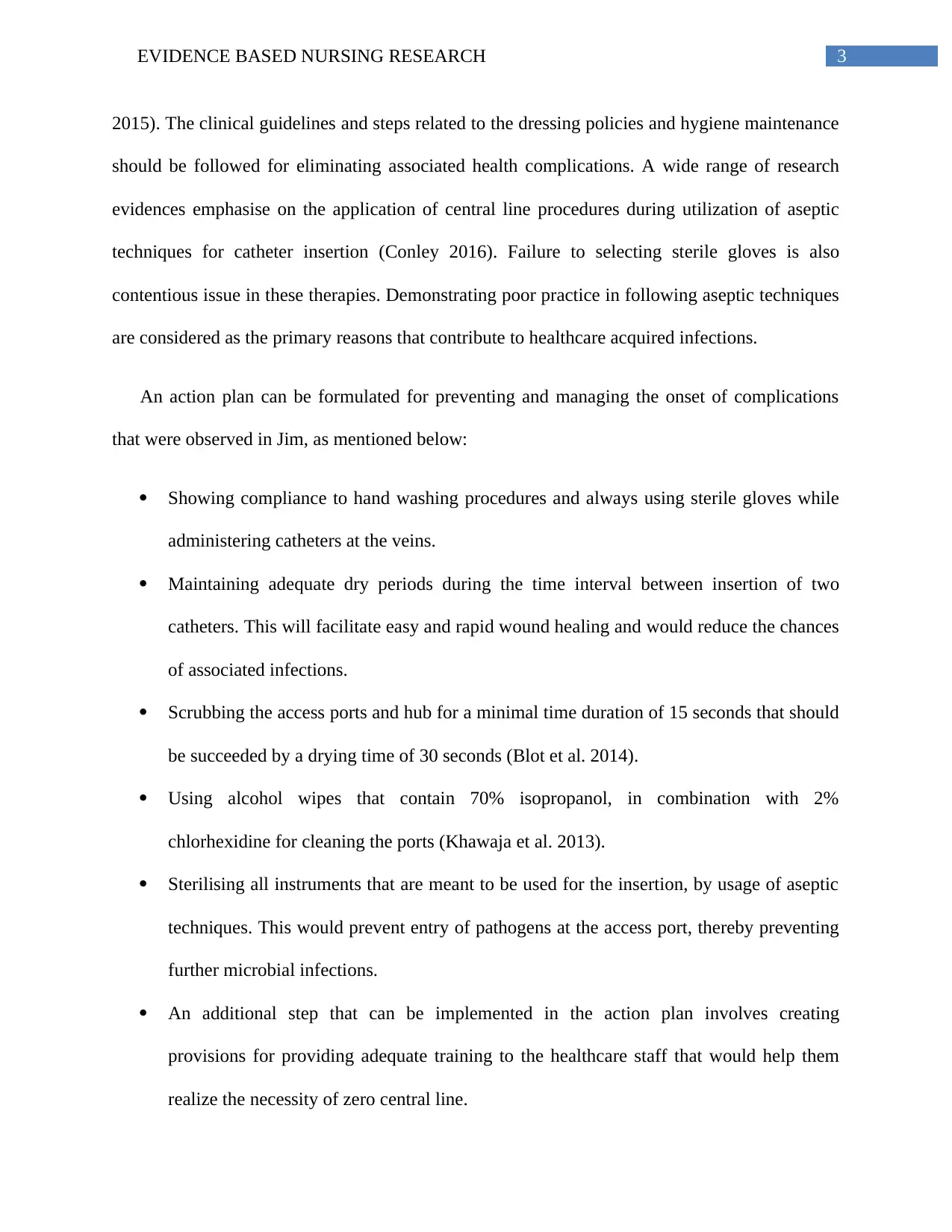
3EVIDENCE BASED NURSING RESEARCH
2015). The clinical guidelines and steps related to the dressing policies and hygiene maintenance
should be followed for eliminating associated health complications. A wide range of research
evidences emphasise on the application of central line procedures during utilization of aseptic
techniques for catheter insertion (Conley 2016). Failure to selecting sterile gloves is also
contentious issue in these therapies. Demonstrating poor practice in following aseptic techniques
are considered as the primary reasons that contribute to healthcare acquired infections.
An action plan can be formulated for preventing and managing the onset of complications
that were observed in Jim, as mentioned below:
Showing compliance to hand washing procedures and always using sterile gloves while
administering catheters at the veins.
Maintaining adequate dry periods during the time interval between insertion of two
catheters. This will facilitate easy and rapid wound healing and would reduce the chances
of associated infections.
Scrubbing the access ports and hub for a minimal time duration of 15 seconds that should
be succeeded by a drying time of 30 seconds (Blot et al. 2014).
Using alcohol wipes that contain 70% isopropanol, in combination with 2%
chlorhexidine for cleaning the ports (Khawaja et al. 2013).
Sterilising all instruments that are meant to be used for the insertion, by usage of aseptic
techniques. This would prevent entry of pathogens at the access port, thereby preventing
further microbial infections.
An additional step that can be implemented in the action plan involves creating
provisions for providing adequate training to the healthcare staff that would help them
realize the necessity of zero central line.
2015). The clinical guidelines and steps related to the dressing policies and hygiene maintenance
should be followed for eliminating associated health complications. A wide range of research
evidences emphasise on the application of central line procedures during utilization of aseptic
techniques for catheter insertion (Conley 2016). Failure to selecting sterile gloves is also
contentious issue in these therapies. Demonstrating poor practice in following aseptic techniques
are considered as the primary reasons that contribute to healthcare acquired infections.
An action plan can be formulated for preventing and managing the onset of complications
that were observed in Jim, as mentioned below:
Showing compliance to hand washing procedures and always using sterile gloves while
administering catheters at the veins.
Maintaining adequate dry periods during the time interval between insertion of two
catheters. This will facilitate easy and rapid wound healing and would reduce the chances
of associated infections.
Scrubbing the access ports and hub for a minimal time duration of 15 seconds that should
be succeeded by a drying time of 30 seconds (Blot et al. 2014).
Using alcohol wipes that contain 70% isopropanol, in combination with 2%
chlorhexidine for cleaning the ports (Khawaja et al. 2013).
Sterilising all instruments that are meant to be used for the insertion, by usage of aseptic
techniques. This would prevent entry of pathogens at the access port, thereby preventing
further microbial infections.
An additional step that can be implemented in the action plan involves creating
provisions for providing adequate training to the healthcare staff that would help them
realize the necessity of zero central line.
Paraphrase This Document
Need a fresh take? Get an instant paraphrase of this document with our AI Paraphraser
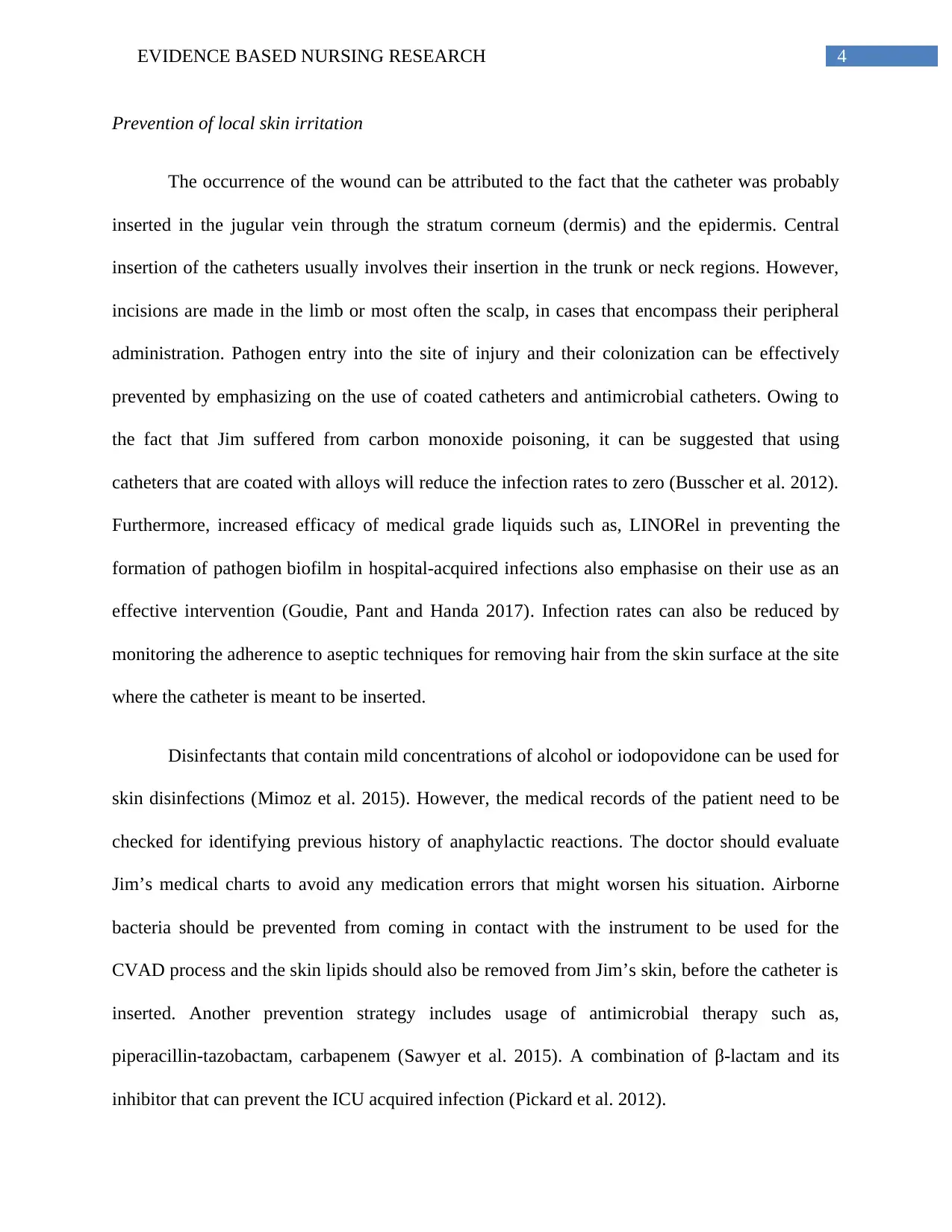
4EVIDENCE BASED NURSING RESEARCH
Prevention of local skin irritation
The occurrence of the wound can be attributed to the fact that the catheter was probably
inserted in the jugular vein through the stratum corneum (dermis) and the epidermis. Central
insertion of the catheters usually involves their insertion in the trunk or neck regions. However,
incisions are made in the limb or most often the scalp, in cases that encompass their peripheral
administration. Pathogen entry into the site of injury and their colonization can be effectively
prevented by emphasizing on the use of coated catheters and antimicrobial catheters. Owing to
the fact that Jim suffered from carbon monoxide poisoning, it can be suggested that using
catheters that are coated with alloys will reduce the infection rates to zero (Busscher et al. 2012).
Furthermore, increased efficacy of medical grade liquids such as, LINORel in preventing the
formation of pathogen biofilm in hospital-acquired infections also emphasise on their use as an
effective intervention (Goudie, Pant and Handa 2017). Infection rates can also be reduced by
monitoring the adherence to aseptic techniques for removing hair from the skin surface at the site
where the catheter is meant to be inserted.
Disinfectants that contain mild concentrations of alcohol or iodopovidone can be used for
skin disinfections (Mimoz et al. 2015). However, the medical records of the patient need to be
checked for identifying previous history of anaphylactic reactions. The doctor should evaluate
Jim’s medical charts to avoid any medication errors that might worsen his situation. Airborne
bacteria should be prevented from coming in contact with the instrument to be used for the
CVAD process and the skin lipids should also be removed from Jim’s skin, before the catheter is
inserted. Another prevention strategy includes usage of antimicrobial therapy such as,
piperacillin-tazobactam, carbapenem (Sawyer et al. 2015). A combination of β-lactam and its
inhibitor that can prevent the ICU acquired infection (Pickard et al. 2012).
Prevention of local skin irritation
The occurrence of the wound can be attributed to the fact that the catheter was probably
inserted in the jugular vein through the stratum corneum (dermis) and the epidermis. Central
insertion of the catheters usually involves their insertion in the trunk or neck regions. However,
incisions are made in the limb or most often the scalp, in cases that encompass their peripheral
administration. Pathogen entry into the site of injury and their colonization can be effectively
prevented by emphasizing on the use of coated catheters and antimicrobial catheters. Owing to
the fact that Jim suffered from carbon monoxide poisoning, it can be suggested that using
catheters that are coated with alloys will reduce the infection rates to zero (Busscher et al. 2012).
Furthermore, increased efficacy of medical grade liquids such as, LINORel in preventing the
formation of pathogen biofilm in hospital-acquired infections also emphasise on their use as an
effective intervention (Goudie, Pant and Handa 2017). Infection rates can also be reduced by
monitoring the adherence to aseptic techniques for removing hair from the skin surface at the site
where the catheter is meant to be inserted.
Disinfectants that contain mild concentrations of alcohol or iodopovidone can be used for
skin disinfections (Mimoz et al. 2015). However, the medical records of the patient need to be
checked for identifying previous history of anaphylactic reactions. The doctor should evaluate
Jim’s medical charts to avoid any medication errors that might worsen his situation. Airborne
bacteria should be prevented from coming in contact with the instrument to be used for the
CVAD process and the skin lipids should also be removed from Jim’s skin, before the catheter is
inserted. Another prevention strategy includes usage of antimicrobial therapy such as,
piperacillin-tazobactam, carbapenem (Sawyer et al. 2015). A combination of β-lactam and its
inhibitor that can prevent the ICU acquired infection (Pickard et al. 2012).
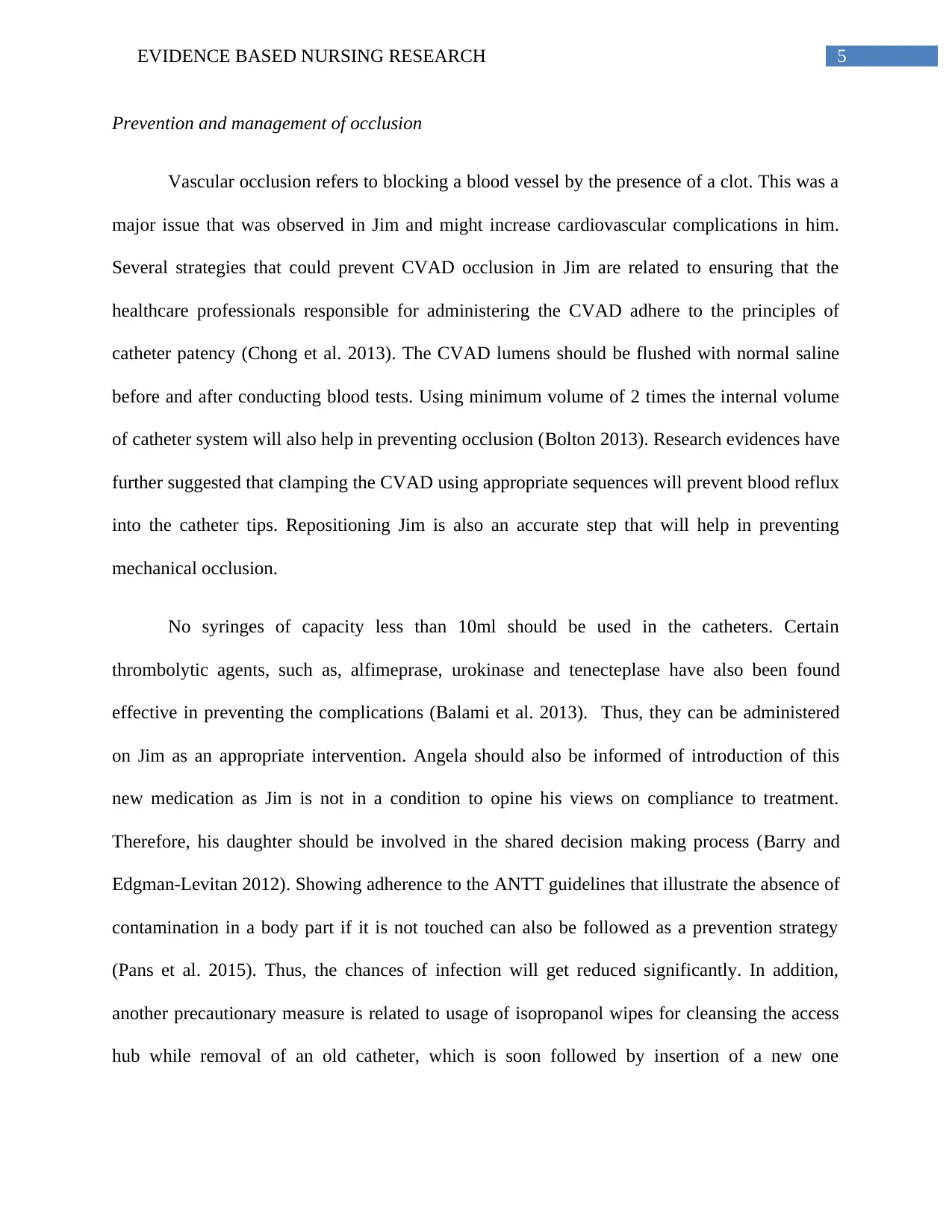
5EVIDENCE BASED NURSING RESEARCH
Prevention and management of occlusion
Vascular occlusion refers to blocking a blood vessel by the presence of a clot. This was a
major issue that was observed in Jim and might increase cardiovascular complications in him.
Several strategies that could prevent CVAD occlusion in Jim are related to ensuring that the
healthcare professionals responsible for administering the CVAD adhere to the principles of
catheter patency (Chong et al. 2013). The CVAD lumens should be flushed with normal saline
before and after conducting blood tests. Using minimum volume of 2 times the internal volume
of catheter system will also help in preventing occlusion (Bolton 2013). Research evidences have
further suggested that clamping the CVAD using appropriate sequences will prevent blood reflux
into the catheter tips. Repositioning Jim is also an accurate step that will help in preventing
mechanical occlusion.
No syringes of capacity less than 10ml should be used in the catheters. Certain
thrombolytic agents, such as, alfimeprase, urokinase and tenecteplase have also been found
effective in preventing the complications (Balami et al. 2013). Thus, they can be administered
on Jim as an appropriate intervention. Angela should also be informed of introduction of this
new medication as Jim is not in a condition to opine his views on compliance to treatment.
Therefore, his daughter should be involved in the shared decision making process (Barry and
Edgman-Levitan 2012). Showing adherence to the ANTT guidelines that illustrate the absence of
contamination in a body part if it is not touched can also be followed as a prevention strategy
(Pans et al. 2015). Thus, the chances of infection will get reduced significantly. In addition,
another precautionary measure is related to usage of isopropanol wipes for cleansing the access
hub while removal of an old catheter, which is soon followed by insertion of a new one
Prevention and management of occlusion
Vascular occlusion refers to blocking a blood vessel by the presence of a clot. This was a
major issue that was observed in Jim and might increase cardiovascular complications in him.
Several strategies that could prevent CVAD occlusion in Jim are related to ensuring that the
healthcare professionals responsible for administering the CVAD adhere to the principles of
catheter patency (Chong et al. 2013). The CVAD lumens should be flushed with normal saline
before and after conducting blood tests. Using minimum volume of 2 times the internal volume
of catheter system will also help in preventing occlusion (Bolton 2013). Research evidences have
further suggested that clamping the CVAD using appropriate sequences will prevent blood reflux
into the catheter tips. Repositioning Jim is also an accurate step that will help in preventing
mechanical occlusion.
No syringes of capacity less than 10ml should be used in the catheters. Certain
thrombolytic agents, such as, alfimeprase, urokinase and tenecteplase have also been found
effective in preventing the complications (Balami et al. 2013). Thus, they can be administered
on Jim as an appropriate intervention. Angela should also be informed of introduction of this
new medication as Jim is not in a condition to opine his views on compliance to treatment.
Therefore, his daughter should be involved in the shared decision making process (Barry and
Edgman-Levitan 2012). Showing adherence to the ANTT guidelines that illustrate the absence of
contamination in a body part if it is not touched can also be followed as a prevention strategy
(Pans et al. 2015). Thus, the chances of infection will get reduced significantly. In addition,
another precautionary measure is related to usage of isopropanol wipes for cleansing the access
hub while removal of an old catheter, which is soon followed by insertion of a new one
⊘ This is a preview!⊘
Do you want full access?
Subscribe today to unlock all pages.

Trusted by 1+ million students worldwide
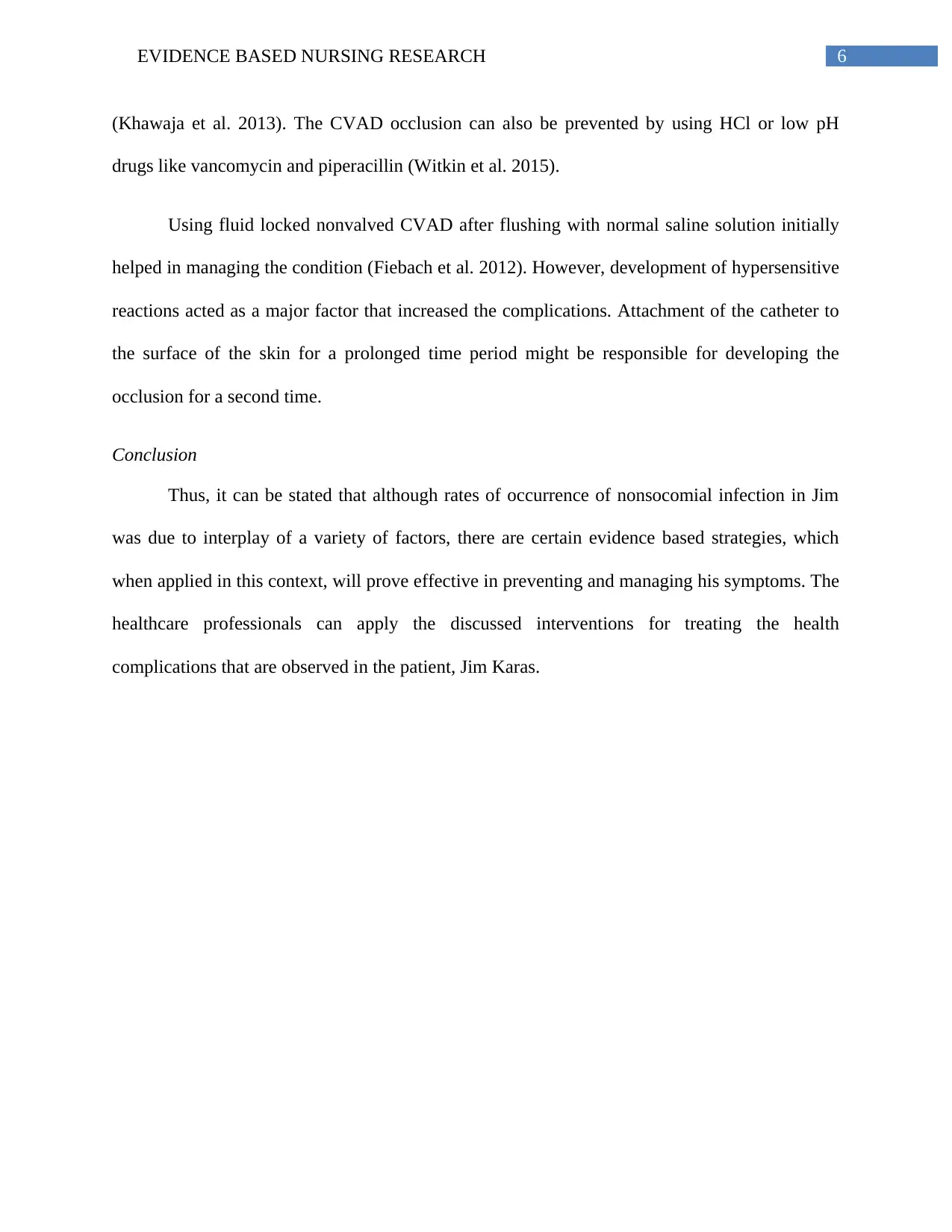
6EVIDENCE BASED NURSING RESEARCH
(Khawaja et al. 2013). The CVAD occlusion can also be prevented by using HCl or low pH
drugs like vancomycin and piperacillin (Witkin et al. 2015).
Using fluid locked nonvalved CVAD after flushing with normal saline solution initially
helped in managing the condition (Fiebach et al. 2012). However, development of hypersensitive
reactions acted as a major factor that increased the complications. Attachment of the catheter to
the surface of the skin for a prolonged time period might be responsible for developing the
occlusion for a second time.
Conclusion
Thus, it can be stated that although rates of occurrence of nonsocomial infection in Jim
was due to interplay of a variety of factors, there are certain evidence based strategies, which
when applied in this context, will prove effective in preventing and managing his symptoms. The
healthcare professionals can apply the discussed interventions for treating the health
complications that are observed in the patient, Jim Karas.
(Khawaja et al. 2013). The CVAD occlusion can also be prevented by using HCl or low pH
drugs like vancomycin and piperacillin (Witkin et al. 2015).
Using fluid locked nonvalved CVAD after flushing with normal saline solution initially
helped in managing the condition (Fiebach et al. 2012). However, development of hypersensitive
reactions acted as a major factor that increased the complications. Attachment of the catheter to
the surface of the skin for a prolonged time period might be responsible for developing the
occlusion for a second time.
Conclusion
Thus, it can be stated that although rates of occurrence of nonsocomial infection in Jim
was due to interplay of a variety of factors, there are certain evidence based strategies, which
when applied in this context, will prove effective in preventing and managing his symptoms. The
healthcare professionals can apply the discussed interventions for treating the health
complications that are observed in the patient, Jim Karas.
Paraphrase This Document
Need a fresh take? Get an instant paraphrase of this document with our AI Paraphraser
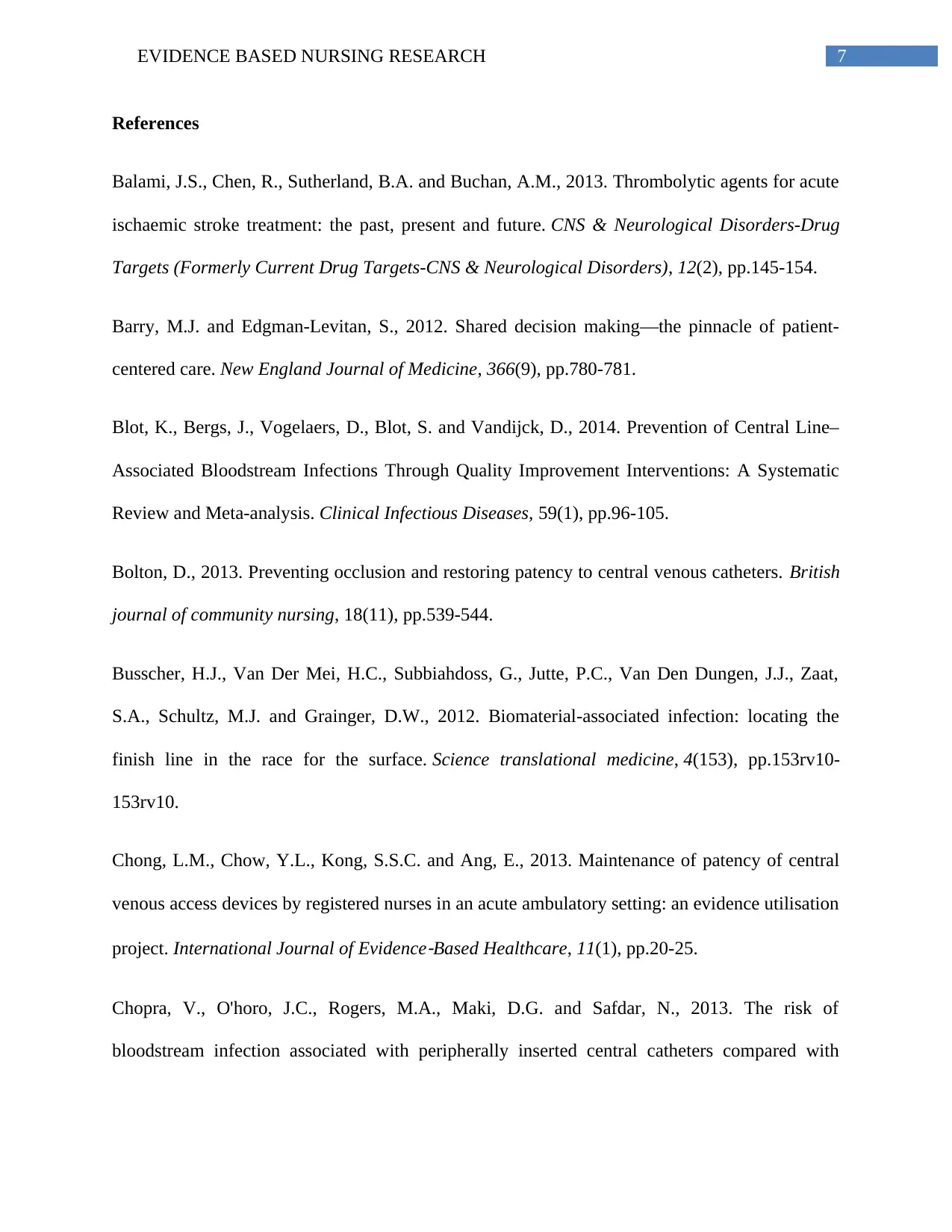
7EVIDENCE BASED NURSING RESEARCH
References
Balami, J.S., Chen, R., Sutherland, B.A. and Buchan, A.M., 2013. Thrombolytic agents for acute
ischaemic stroke treatment: the past, present and future. CNS & Neurological Disorders-Drug
Targets (Formerly Current Drug Targets-CNS & Neurological Disorders), 12(2), pp.145-154.
Barry, M.J. and Edgman-Levitan, S., 2012. Shared decision making—the pinnacle of patient-
centered care. New England Journal of Medicine, 366(9), pp.780-781.
Blot, K., Bergs, J., Vogelaers, D., Blot, S. and Vandijck, D., 2014. Prevention of Central Line–
Associated Bloodstream Infections Through Quality Improvement Interventions: A Systematic
Review and Meta-analysis. Clinical Infectious Diseases, 59(1), pp.96-105.
Bolton, D., 2013. Preventing occlusion and restoring patency to central venous catheters. British
journal of community nursing, 18(11), pp.539-544.
Busscher, H.J., Van Der Mei, H.C., Subbiahdoss, G., Jutte, P.C., Van Den Dungen, J.J., Zaat,
S.A., Schultz, M.J. and Grainger, D.W., 2012. Biomaterial-associated infection: locating the
finish line in the race for the surface. Science translational medicine, 4(153), pp.153rv10-
153rv10.
Chong, L.M., Chow, Y.L., Kong, S.S.C. and Ang, E., 2013. Maintenance of patency of central
venous access devices by registered nurses in an acute ambulatory setting: an evidence utilisation
project. International Journal of Evidence
‐Based Healthcare, 11(1), pp.20-25.
Chopra, V., O'horo, J.C., Rogers, M.A., Maki, D.G. and Safdar, N., 2013. The risk of
bloodstream infection associated with peripherally inserted central catheters compared with
References
Balami, J.S., Chen, R., Sutherland, B.A. and Buchan, A.M., 2013. Thrombolytic agents for acute
ischaemic stroke treatment: the past, present and future. CNS & Neurological Disorders-Drug
Targets (Formerly Current Drug Targets-CNS & Neurological Disorders), 12(2), pp.145-154.
Barry, M.J. and Edgman-Levitan, S., 2012. Shared decision making—the pinnacle of patient-
centered care. New England Journal of Medicine, 366(9), pp.780-781.
Blot, K., Bergs, J., Vogelaers, D., Blot, S. and Vandijck, D., 2014. Prevention of Central Line–
Associated Bloodstream Infections Through Quality Improvement Interventions: A Systematic
Review and Meta-analysis. Clinical Infectious Diseases, 59(1), pp.96-105.
Bolton, D., 2013. Preventing occlusion and restoring patency to central venous catheters. British
journal of community nursing, 18(11), pp.539-544.
Busscher, H.J., Van Der Mei, H.C., Subbiahdoss, G., Jutte, P.C., Van Den Dungen, J.J., Zaat,
S.A., Schultz, M.J. and Grainger, D.W., 2012. Biomaterial-associated infection: locating the
finish line in the race for the surface. Science translational medicine, 4(153), pp.153rv10-
153rv10.
Chong, L.M., Chow, Y.L., Kong, S.S.C. and Ang, E., 2013. Maintenance of patency of central
venous access devices by registered nurses in an acute ambulatory setting: an evidence utilisation
project. International Journal of Evidence
‐Based Healthcare, 11(1), pp.20-25.
Chopra, V., O'horo, J.C., Rogers, M.A., Maki, D.G. and Safdar, N., 2013. The risk of
bloodstream infection associated with peripherally inserted central catheters compared with
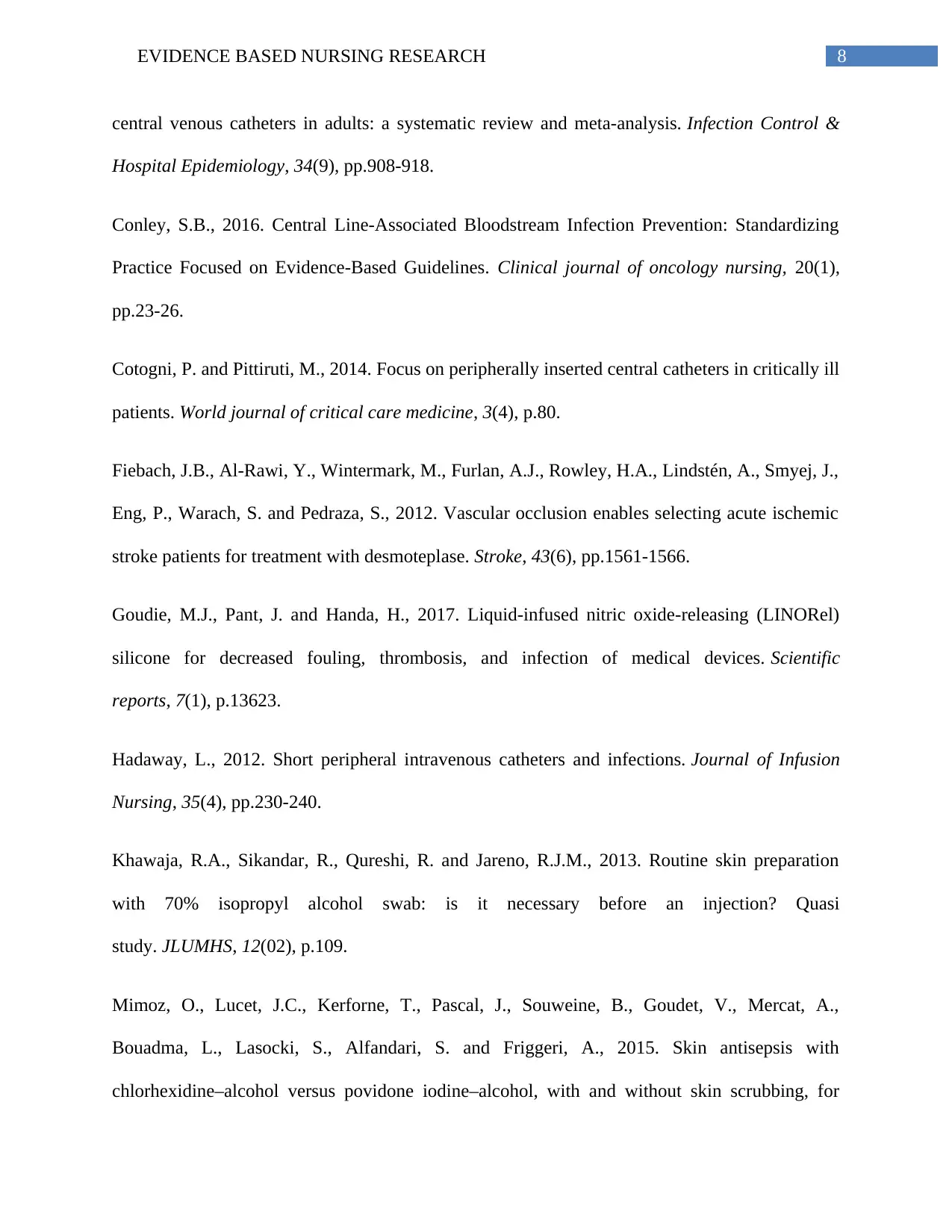
8EVIDENCE BASED NURSING RESEARCH
central venous catheters in adults: a systematic review and meta-analysis. Infection Control &
Hospital Epidemiology, 34(9), pp.908-918.
Conley, S.B., 2016. Central Line-Associated Bloodstream Infection Prevention: Standardizing
Practice Focused on Evidence-Based Guidelines. Clinical journal of oncology nursing, 20(1),
pp.23-26.
Cotogni, P. and Pittiruti, M., 2014. Focus on peripherally inserted central catheters in critically ill
patients. World journal of critical care medicine, 3(4), p.80.
Fiebach, J.B., Al-Rawi, Y., Wintermark, M., Furlan, A.J., Rowley, H.A., Lindstén, A., Smyej, J.,
Eng, P., Warach, S. and Pedraza, S., 2012. Vascular occlusion enables selecting acute ischemic
stroke patients for treatment with desmoteplase. Stroke, 43(6), pp.1561-1566.
Goudie, M.J., Pant, J. and Handa, H., 2017. Liquid-infused nitric oxide-releasing (LINORel)
silicone for decreased fouling, thrombosis, and infection of medical devices. Scientific
reports, 7(1), p.13623.
Hadaway, L., 2012. Short peripheral intravenous catheters and infections. Journal of Infusion
Nursing, 35(4), pp.230-240.
Khawaja, R.A., Sikandar, R., Qureshi, R. and Jareno, R.J.M., 2013. Routine skin preparation
with 70% isopropyl alcohol swab: is it necessary before an injection? Quasi
study. JLUMHS, 12(02), p.109.
Mimoz, O., Lucet, J.C., Kerforne, T., Pascal, J., Souweine, B., Goudet, V., Mercat, A.,
Bouadma, L., Lasocki, S., Alfandari, S. and Friggeri, A., 2015. Skin antisepsis with
chlorhexidine–alcohol versus povidone iodine–alcohol, with and without skin scrubbing, for
central venous catheters in adults: a systematic review and meta-analysis. Infection Control &
Hospital Epidemiology, 34(9), pp.908-918.
Conley, S.B., 2016. Central Line-Associated Bloodstream Infection Prevention: Standardizing
Practice Focused on Evidence-Based Guidelines. Clinical journal of oncology nursing, 20(1),
pp.23-26.
Cotogni, P. and Pittiruti, M., 2014. Focus on peripherally inserted central catheters in critically ill
patients. World journal of critical care medicine, 3(4), p.80.
Fiebach, J.B., Al-Rawi, Y., Wintermark, M., Furlan, A.J., Rowley, H.A., Lindstén, A., Smyej, J.,
Eng, P., Warach, S. and Pedraza, S., 2012. Vascular occlusion enables selecting acute ischemic
stroke patients for treatment with desmoteplase. Stroke, 43(6), pp.1561-1566.
Goudie, M.J., Pant, J. and Handa, H., 2017. Liquid-infused nitric oxide-releasing (LINORel)
silicone for decreased fouling, thrombosis, and infection of medical devices. Scientific
reports, 7(1), p.13623.
Hadaway, L., 2012. Short peripheral intravenous catheters and infections. Journal of Infusion
Nursing, 35(4), pp.230-240.
Khawaja, R.A., Sikandar, R., Qureshi, R. and Jareno, R.J.M., 2013. Routine skin preparation
with 70% isopropyl alcohol swab: is it necessary before an injection? Quasi
study. JLUMHS, 12(02), p.109.
Mimoz, O., Lucet, J.C., Kerforne, T., Pascal, J., Souweine, B., Goudet, V., Mercat, A.,
Bouadma, L., Lasocki, S., Alfandari, S. and Friggeri, A., 2015. Skin antisepsis with
chlorhexidine–alcohol versus povidone iodine–alcohol, with and without skin scrubbing, for
⊘ This is a preview!⊘
Do you want full access?
Subscribe today to unlock all pages.

Trusted by 1+ million students worldwide
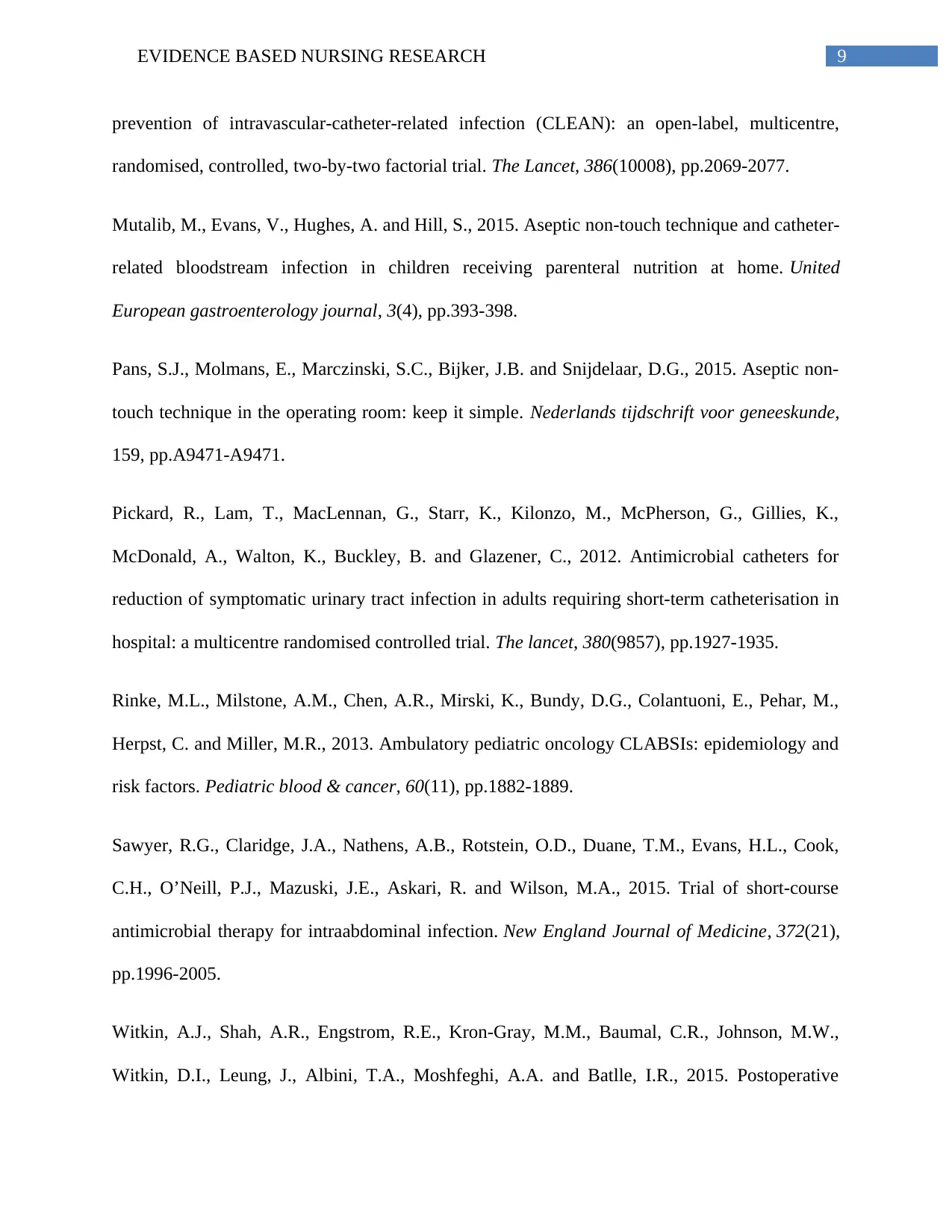
9EVIDENCE BASED NURSING RESEARCH
prevention of intravascular-catheter-related infection (CLEAN): an open-label, multicentre,
randomised, controlled, two-by-two factorial trial. The Lancet, 386(10008), pp.2069-2077.
Mutalib, M., Evans, V., Hughes, A. and Hill, S., 2015. Aseptic non-touch technique and catheter-
related bloodstream infection in children receiving parenteral nutrition at home. United
European gastroenterology journal, 3(4), pp.393-398.
Pans, S.J., Molmans, E., Marczinski, S.C., Bijker, J.B. and Snijdelaar, D.G., 2015. Aseptic non-
touch technique in the operating room: keep it simple. Nederlands tijdschrift voor geneeskunde,
159, pp.A9471-A9471.
Pickard, R., Lam, T., MacLennan, G., Starr, K., Kilonzo, M., McPherson, G., Gillies, K.,
McDonald, A., Walton, K., Buckley, B. and Glazener, C., 2012. Antimicrobial catheters for
reduction of symptomatic urinary tract infection in adults requiring short-term catheterisation in
hospital: a multicentre randomised controlled trial. The lancet, 380(9857), pp.1927-1935.
Rinke, M.L., Milstone, A.M., Chen, A.R., Mirski, K., Bundy, D.G., Colantuoni, E., Pehar, M.,
Herpst, C. and Miller, M.R., 2013. Ambulatory pediatric oncology CLABSIs: epidemiology and
risk factors. Pediatric blood & cancer, 60(11), pp.1882-1889.
Sawyer, R.G., Claridge, J.A., Nathens, A.B., Rotstein, O.D., Duane, T.M., Evans, H.L., Cook,
C.H., O’Neill, P.J., Mazuski, J.E., Askari, R. and Wilson, M.A., 2015. Trial of short-course
antimicrobial therapy for intraabdominal infection. New England Journal of Medicine, 372(21),
pp.1996-2005.
Witkin, A.J., Shah, A.R., Engstrom, R.E., Kron-Gray, M.M., Baumal, C.R., Johnson, M.W.,
Witkin, D.I., Leung, J., Albini, T.A., Moshfeghi, A.A. and Batlle, I.R., 2015. Postoperative
prevention of intravascular-catheter-related infection (CLEAN): an open-label, multicentre,
randomised, controlled, two-by-two factorial trial. The Lancet, 386(10008), pp.2069-2077.
Mutalib, M., Evans, V., Hughes, A. and Hill, S., 2015. Aseptic non-touch technique and catheter-
related bloodstream infection in children receiving parenteral nutrition at home. United
European gastroenterology journal, 3(4), pp.393-398.
Pans, S.J., Molmans, E., Marczinski, S.C., Bijker, J.B. and Snijdelaar, D.G., 2015. Aseptic non-
touch technique in the operating room: keep it simple. Nederlands tijdschrift voor geneeskunde,
159, pp.A9471-A9471.
Pickard, R., Lam, T., MacLennan, G., Starr, K., Kilonzo, M., McPherson, G., Gillies, K.,
McDonald, A., Walton, K., Buckley, B. and Glazener, C., 2012. Antimicrobial catheters for
reduction of symptomatic urinary tract infection in adults requiring short-term catheterisation in
hospital: a multicentre randomised controlled trial. The lancet, 380(9857), pp.1927-1935.
Rinke, M.L., Milstone, A.M., Chen, A.R., Mirski, K., Bundy, D.G., Colantuoni, E., Pehar, M.,
Herpst, C. and Miller, M.R., 2013. Ambulatory pediatric oncology CLABSIs: epidemiology and
risk factors. Pediatric blood & cancer, 60(11), pp.1882-1889.
Sawyer, R.G., Claridge, J.A., Nathens, A.B., Rotstein, O.D., Duane, T.M., Evans, H.L., Cook,
C.H., O’Neill, P.J., Mazuski, J.E., Askari, R. and Wilson, M.A., 2015. Trial of short-course
antimicrobial therapy for intraabdominal infection. New England Journal of Medicine, 372(21),
pp.1996-2005.
Witkin, A.J., Shah, A.R., Engstrom, R.E., Kron-Gray, M.M., Baumal, C.R., Johnson, M.W.,
Witkin, D.I., Leung, J., Albini, T.A., Moshfeghi, A.A. and Batlle, I.R., 2015. Postoperative
Paraphrase This Document
Need a fresh take? Get an instant paraphrase of this document with our AI Paraphraser

10EVIDENCE BASED NURSING RESEARCH
hemorrhagic occlusive retinal vasculitis: expanding the clinical spectrum and possible
association with vancomycin. Ophthalmology, 122(7), pp.1438-1451.
hemorrhagic occlusive retinal vasculitis: expanding the clinical spectrum and possible
association with vancomycin. Ophthalmology, 122(7), pp.1438-1451.
1 out of 11
Related Documents
Your All-in-One AI-Powered Toolkit for Academic Success.
+13062052269
info@desklib.com
Available 24*7 on WhatsApp / Email
![[object Object]](/_next/static/media/star-bottom.7253800d.svg)
Unlock your academic potential
Copyright © 2020–2025 A2Z Services. All Rights Reserved. Developed and managed by ZUCOL.





